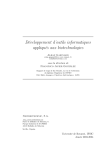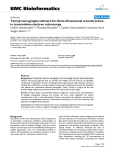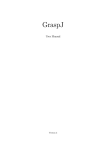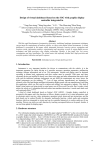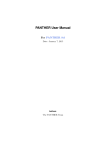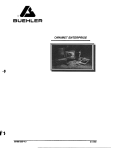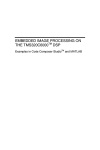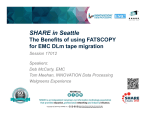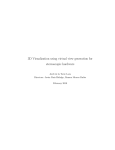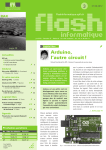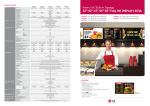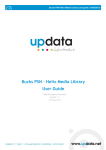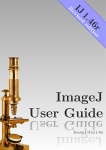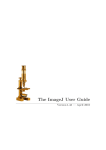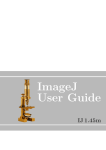Download Parameter Selection using Evolutionary Strategies in - MPI-CBG
Transcript
Parameter Selection using Evolutionary Strategies in ImageJ Roland Bärtschi Advisor: Janick Cardinale, Prof. Dr. Ivo Sbalzarini 04.07.2011 Abstract ImageJ is an open source image processing tool written in Java which is extendible through macros as well as through plug-ins. There exists a large collection of both kinds of extensions for various tasks such as image segmentation. Plug-ins often have various arguments and complex macros a lot of parameters. These need usually be selected by hand which is a task that often depends on prior knowledge for what values produce the expected results. In the absence of this knowledge the parameters are usually found by trying a few values until the results approximately match the expectations. The Plug-in developed in this thesis aims at automating this process with an intuitive user interface using Evolution Strategies such that the work on the user side mostly consists of ranking a few results in comparison to one another until a satisfying result has been reached. Contents 1 Introduction 2 2 ImageJ 2 2.1 2.2 ImageJ 1.4x and Fiji . . . . . . . . . . . . . . . . . . . . . . . . . . . 2 2.1.1 Core classes of ImageJ . . . . . . . . . . . . . . . . . . . . . . 2 2.1.2 Plug-ins . . . . . . . . . . . . . . . . . . . . . . . . . . . . . . 3 2.1.3 Macros 2.1.4 Fiji is just ImageJ ImageJ 2.0 . . . . . . . . . . . . . . . . . . . . . . . . . . . . . . 3 . . . . . . . . . . . . . . . . . . . . . . . . 3 . . . . . . . . . . . . . . . . . . . . . . . . . . . . . . . . 3 3 Evolution Strategies 3 4 The Parameter Optimization Plug-in 4 4.1 4.2 4.3 View . . . . . . . . . . . . . . . . . . . . . . . . . . . . . . . . . . . . 4 4.1.1 The Selection UI . . . . . . . . . . . . . . . . . . . . . . . . . 4 4.1.2 The Ranking UI . . . . . . . . . . . . . . . . . . . . . . . . . 4 Controller . . . . . . . . . . . . . . . . . . . . . . . . . . . . . . . . . 5 Model . . . . . . . . . . . . . . . . . . . . . . . . . . . . . . . . . . . 4.3.1 Parameterized Macro 4.3.2 Evolution Strategies 6 . . . . . . . . . . . . . . . . . . . . . . 6 . . . . . . . . . . . . . . . . . . . . . . . 7 5 Future Work 8 Appendix A. User Manual 9 References 14 1 1 2.1.1 Core classes of ImageJ Introduction As a rst step towards this thesis the current implemen- Images of all sorts have become an important data tation of ImageJ has been analyzed in order to make source for various elds of academia as well as for in- use of the existing code as much as possible. Unfortu- dustrial applications. With the ever increasing amount nately it turned out to be much more dicult to do so of images which are being produced the task of process- than expected because of the architecture and the spe- ing them becomes more and more important. ImageJ is cic implementation of the core classes of ImageJ. Many an open source image processing tool which is written methods and elds in the core classes have default visi- in Java and is therefore very portable. ImageJ oers the bility which makes them visible to other classes within essential image processing tools as its basic features and the same package which unfortunately is of no use when allows for extensions through plug-ins as well as through macros. developing a plug-in which is being loaded by a dier- Macros can even be produced by recording ent class loader which makes it impossible to access any the users interaction with ImageJ which makes it rather of those elds or methods no matter what package the easy to automate complex processing steps. Typical im- accessing class is in. age processing tasks such as image segmentation often Lets never the less take a look at some of the core involve many parameters which have to be chosen by hand. classes of ImageJ which matter for the implementation In some cases one might have prior knowledge of this plug-in. about what might be good values for a specic parameter and in other cases one has to try one value after IJ an other in order to nd one which is suitable for the purpose of the task at hand. This class is the core or ImageJ and all its elds and The aim of this thesis is to create a Plug-in for ImageJ which automates this process in such a way that methods are static. it guides the user through an optimization procedure ods which are used by other classes and is the center of It contains a lot of utility meth- where they are only required to select the parameters interaction with ImageJ. which need to be optimized and to rank results based on their mutual quality. ImagePlus The idea is to use Evolution Strategies such that the resulting images become better in each iteration based on the user's ranking until they The ImagePlus class is basically a wrapper for the im- are satised with one of the results and choose to apply age. the selected parameter values on the original image. stack of images. It can either contain a single image or a whole Besides the image/stack data it also contains some meta data on the image such as width and height. It also contains the ImageProcessor which 2 is used to manipulate the image and for images which ImageJ are more than 2 dimensional it contains an ImageStack which basically consists of an array of images. 2.1 ImageJ 1.4x and Fiji ImageStack ImageJ is an open source image processing toolkit which is implemented in Java. It supports many le formats An ImageStack is an expandable array of slices which such as PNG, JPEG, BMP, GIF etc. and images in the following data formats: are arrays of pixels. The pixels of the current slice can 8-bit grayscale, 8-bit indexed then be used to create a new ImageProcessor. color, 16-bit unsigned integer, 32-bit oating-point and 32-bit RGB color. It is extendibe through macros and retrieved and set using methods of this class. plug-ins. Macros can be used for automation of processing steps or complex processing pipelines. It is possible ImageProcessor to record the actions performed by the user on ImageJ in the form of a macro. Slices can be added or removed and some meta data can be Macros can be edited, saved and run at any time. Plug-ins are an even more power- ImageProcessor is used to operate on images and is the full extension because they can contain arbitrary Java basic container holding the pixels of an image. Image- code which can interact with ImageJ through a specied Processor is an abstract class which is extended by the interface. There are plug-ins available for download on classes ByteProcessor, ColorProcessor, FloatProcessor various websites and ImageJ even contains a text edi- and ShortProcessor which implement the basic data ma- tor and java compiler for writing plug-ins. ImageJ can nipulation operations based on the type of the pixels. be used as an application or as a toolkit. ImageJ is ImageWindow one of the fastest Java image processing tools available. Basic editing and processing features are already implemented as tools. There are for example various selection This class extends the AWT Frame class and is the ba- tools for rectangular, elliptical etc. shapes which can be sic window which is used to display images in ImageJ. combined and make it possible to apply other tools and It contains an instance of ImageCanvas which is where operations just to the selected area. the image is actually painted on the UI. 2 ImageCanvas 2.1.4 Fiji is just ImageJ This is an extension of the AWT Canvas class which As the maintainers of Fiji put it: is used to draw an image in ImageJ. It is associated Fiji is an image processing package. It with an instance of ImagePlus from which it retrieves can be described as a distribution of Im- the AWT Image which it draws. This class implements ageJ together with Java, Java 3D and a mouse and keyboard listener interfaces which are being lot of plug-ins organized into a coherent used for interacting with the image. Based on the tool menu structure. Fiji compares to ImageJ as which is selected in the tool bar of the main window Ubuntu compares to Linux. of ImageJ a click or turn of the mouse wheel can have dierent eects on how the image is being displayed. It 1 As stated in this quote Fiji is based on ImageJ and ex- is also creating the region of interest selections on the tends it with useful features such as an updating mech- ImagePlus instance that is being displayed. anism and a large collection of plug-ins. Fiji also introduced ImgLib which will be used for image representation in ImageJ2. The plug-in accordingly works both in These core classes are strongly interlinked and it is a basic build of ImageJ as well as in Fiji. dicult to extend one without having to extend others due that strong dependency and the visibility of some elds and methods. 2.2 One more class is worth being mentioned here and ImageJ 2.0 that is WindowManager. This class is as its name sug- The release of the next major version of ImageJ is due gests a manager for the windows in ImageJ but it has in October also a role in ImageJ which is important for the process- in June. ImageJ 2.0 is being redesigned from ground up ing of the images in the plug-in developed in this thesis. using modern Software Engineering principles to make it ImageJ uses the WindowManager to determine on which more modular and extendible. One of the many changes image a macro is going to be run. This is usually the is about the representation of the data. In previous ver- image contained in the instance of ImageWindow which sions data was represented as an image or as a stack was last in focus but it can also temporarily be set to of Images organized in slices. a dierent ImagePlus instance with a call to setTem- allows for arbitrary dimensional data by arranging the pCurrentImage. This is important because it makes it slices in a particular order it can become very inecient possible to run a macro on an image which is not dis- for high dimensional data in terms of memory access. This played in an instance of ImageWindow as it will be the issue Toman£ák case in the plug-in. 2 and a rst beta version should be released and has been Saalfel Although this basically addressed who developed by Preibisch, ImgLib[3], a generic Java Image Processing library which is already in use in Fiji. ImgLib allows to implement image pro- 2.1.2 Plug-ins cessing algorithms independent of the type of data that is being processed. Plug-ins in ImageJ can be anything from an analysis tool to an image generator and it need not even have to do which denes a data type and the operations on it and anything with ImageJ. All that's required for a plug-in Container which addresses the storage of the data. Due to be used in ImageJ is that its main class implements to the generic structure of ImgLib some performance the PlugIn interface or if the plug-in is supposed to ma- issues have appeared for various plug-ins using it but nipulate the currently focused image then it can also implement the PlugInFilter interface. This is achieved through the Cur- sor which denes an access strategy for the data, Type many of them have been addressed and resolved with Just one more ImgLib2 which is now the basic data library in ImageJ2. detail needs to be taken into account and that is that Through the extensive use of interfaces in ImageJ2 the name needs to contain an underscore in order for many of the before mentioned problems of extending ImageJ to recognize it as a plug-in. But besides that it an existing class of ImageJ have basically been elimi- can contain arbitrary libraries and can have a user inter- nated. There is for example now an interface ImageCan- face implemented using a framework other than AWT vas which can be implemented to draw images and that or Swing. implementation could then be used to replace an existing implementation such as AWTImageCanvas which is 2.1.3 Macros the basic AWT implementation of said interface without any problems. As mentioned in the introduction ImageJ also oers the possibility to automate processes with macros which can 3 even be recorded from actions performed in ImageJ. Evolution Strategies This makes automation quite easy but macros can also be written by hand. Macros have a Java like syntax and Evolution Strategies are one subclass of Evolutionary can basically run all features which are also available in Algorithms which are often used for optimization prob- the user interface. lems. Evolutionary Algorithms mimic Darwin's natural 1 Ocial website: http://ji.sc/wiki/index.php/Fiji 2 See roadmap of the development project on http://imagejdev.org 3 selection principle in that they consist of a mutation, re- The UI has been implemented using Swing and uses only combination and selection operators which are applied standard components and containers. to individuals of a generation which leads to a next gen- 4.1.2 The Ranking UI eration. One kind of Evolution Strategies are so called individuals This UI is used to select and rank the images which have individuals is been produced by applying the macro with the parame- The selection operation is based on the t- ters set to the values of the individuals of the evolution ES which consider a parent generation of from which an ospring generation of created. (µ, λ)- λ µ ness which is associated with each individual and selects strategy. those individuals which have the largest tness. An indi- from the evolution process as it is possible to set arbi- vidual of the population consists of an object parameter trary ImagePlus resources for the images. value y, a set of strategy parameters s But it is not restricted to displaying images The constructor of the UI takes three arguments. and its tness The rst one is the number of images which will be dis- F (y). played in this window. The second is the minimal num- 4 The Parameter ber of images which need to be selected to make a step Optimization of the evolution process and the third is the maximal number of images which are to be selected. By selecting Plug-in an image it is being assigned the next rank starting from Before the plug-in can be used the user needs to open 1. This rank is then passed back to the controller which the image on which the optimization is supposed to be uses it to compute the tness of each individual. performed. The UI consists of 4 main areas: The macro which is to be applied on the image needs to be written to a le in order to load it • into the plug-in. Once these conditions are met the user On the top there is a small information area which displays the instruction of how many images need can use the plug-in. to be selected and it also contains a small info icon The macro has been implemented with a focus on the which expands a hidden label if the user hovers the MVC pattern so in the following sub sections the model, mouse over it. In this hidden label are further in- view and controller are being discussed separately. structions on how to use the ui and which tools of ImageJ work on the displayed images. 4.1 View • One of the main goals of this thesis is to make the pro- images. Using the scroll wheel of the mouse one cess of nding good parameters for a macro an easy can scroll through the slices of the image if it is a task. Therefore the user interface needs to be intuitive stack. If the hand tool is selected in the ImageJ and should only require a minimal amount of work by the user. toolbar then one can pan the images if they are To guide the user through the process each zoomed in. If the zoom tool is enabled then a left step has been labeled accordingly. You can see a walk mouse click zooms all images in and a right mouse through with each step of the procedure in the user man- click zooms all images out. It is also possible to ual in Appendix A. pan the images if the hand tool is not selected but if the space bar is held down. The last manipula- 4.1.1 The Selection UI tion of the display is possible by holding the shift key and scrolling the mouse wheel. This changes The selection UI is where all necessary congurations the opacity of the overlay image which is the orig- for the optimization process are made. It contains • In the center is the main panel which contains the inal image before the macro has been applied to a button which opens a le dialog to select the it. macro, • • a drop down box to select the strategy, • a check box to select whether or not to generate a ulating the image display with scroll bars instead of the scroll wheel. This is also where the current slice or zoom factor is displayed along with the history of the optimization process which can then opacity of the overlay image. be imported into MATLAB, • • a table for the selection and conguration of the On the bottom right there is an area containing 4 buttons along with a short description of what parameters which are found in the macro, • On the bottom left there are controls for manip- their purpose is. There is a text plane where the macro is displayed and the line containing the currently selected macro a 'clear selection' button which clears the selection that has been made, is highlighted, a 'Next' botton which is enabled as soon as • a button to save the conguration • and a button to start the optimization process lected/ranked and which calls the controller once all necessary settings have been made. to make a next optimization step, the required number of images has been se- 4 Figure 1: The Selection UI with a simple segmentation macro. a 'Repeat' button which can be used to re- implementations of either the controller or the user in- sample the current population without select- terface can be changed without changes to the other. It ing/ranking any images and it is only enabled also allows to hide methods of the controller intended as long as no images are currently selected to be used by the selection UI from the ranking UI and vice versa. and a 'Finish' button which completes the The conguration of the plug-in which includes optimization and calls the controller to apply the macro with the value of the selected image on the input image. If more than one image is selected then the controller will rst • the selected le containing the macro, • the ag for whether or not the history of the val- compute the mean of the selected values and ues and assigned tnesses is being exported at the then apply the macro with the mean to the end of the optimization process, input image. The controls in the bottom left are synchronized with • the selected Evolution Strategy, • and the settings for the parameters in the parameterized macro the displayed images such that a click zoom also changes the value of the zoom scroll bar. is being stored in an instance of class Conguration The slice selection scroll bar is only displayed if the which can be written to a le and later again loaded image is a stack such that the user only sees controls from a le to avoid having to congure the same pa- which he can actually use. rameters again and again for each image on which the In order to display the images a customized Canvas optimization plug-in is being run. subclass has been implemented which contains a few The controller creates both an instance of Param- lines of code from the ImageCanvas class which ImageJ eterRankingUI and of ParameterSelectionUI which are uses in the standard image displaying windows. being used for interaction with the user. These instances are being created at the point where they are rst re- 4.2 The quired. Controller main class of For the ParameterSelectionUI this is already upon start of the plug-in and the ParameterRankingUI the plug-in is the Parame- is being created when the conguration is complete and ter_Optimization_Plugin class which implements the the optimization has been started. PluginFilter interface and the two internally used con- Besides the use of ImagePlus in the Ranking UI the troller interfaces. Those internal interfaces are used to class Parameter_Optimization_Plugin is the only class separate the controller from the user interface such that which directly interacts with ImageJ so the classes for 5 Figure 2: Ranking UI with one ranked image. (Slice scroll bar hidden because image is not a stack) the user interface are independent of ImageJ and could Tokenizer be used with other libraries through a dierent con- tk = new Tokenizer ( ) ; Program pgm = t k . t o k e n i z e ( m a c r o S t r i n g ) ; troller class. where the Tokenizer and Program classes of ImageJ 4.3 Model are used. This is basically the same step that the macro interpreter of ImageJ makes before actually interpreting The model in this application consists of the parameter- the code. The instance of Program which is being cre- ized macro and the Evolution Strategies. ated here contains a list of of tokens such as an if -token 4.3.1 Parameterized Macro or a opening bracket token. Unfortunately the current In order to detect parameters in a macro script a simple into an AST macro parser has been implemented which recognizes and evaluate the statements which are being recognized possible parameters in function calls. The parameters and run the plug-ins which are being called. Given an which can be detected need either be numbers or be con- AST it would have been much easier to nd possible pa- tained in a constant string argument having the form rameters. Given the lack of said AST the tokens are be- name=value. Numbers in other places such as loops ing processed sequentially and when a token is reached and if-statements are ignored and treated as static code. which stands for a function name then an attempt is The macro parsing is implemented in the Parame- made to parse a parameterized method. This attempt terizedMacro class which needs to be instantiated with succeeds if either a number is found as an argument or a string containing the macro code. This code is then a constant string which contains at least one substring split into tokens by matching the before mentioned name=value pattern 3 Abstract version of ImageJ does not actually parse these tokens 3 but rather sequentially process the tokens Syntax Tree which is a tree like representation of the code. 6 where name consists of letters and numbers and value Retrieve the minimal number of individuals which can be parsed as an instance of type double. If no po- need to have positive tness. tential parameter is found in the function call or if an set in the ranking UI as the minimal number of unexpected token appears in the argument list of the images which need to be ranked before a next step function call then the whole sequence of tokens making can be made. This value is then up the function call is treated as static code and written into a string. public int But if at least one potential parameter is found then an instance of Parameter is being created getMaxSelectionSize ( ) ; and instantiated with the value of the parameter in the Retrieve the maximal number of individuals whose macro. assigned tness will be used in the evolution step. This way at the end of the parsing step we get a list This value is then set in the ranking UI as the of Strings and Doubles which are being referred to by maximal number of images which can be ranked instances of Parameter with corresponding Parameter- in each step. Settings which make up the whole macro. Whenever a public void new instance of Parameter is being created a reference to this instance is added to the list of parameters such setInitialX ( double [ ] x); that it is possible to directly manipulate the values of Set the initial value from which the rst popula- the parameters within the macro. tion is created. In order to run the macro the code list containing the public void Strings and instances of Parameter are simply being concatenated and then this new macro string is passed to initialize (); Initialize the strategy. Once the strategy has been the runMacro method of ImageJ. In the concatenation initialized there will always be a current popula- process the toString method is called on each instance tion available. of Parameter which inserts the current values into the right positions within the macro string and thus runs public void the macro with the current values for the parameters. setFitness ( double [ ] fitness ); Set the tness of the individuals of the population. 4.3.2 Evolution Strategies The tness is determined by the ranks which have The plug-in uses the interface EvolutionStrategy to in- been assigned to the images and set to be the in- teract with strategy implementations during the opti- verse of the rank for all non-zero ranks. mization process. public void Following are the methods which a strategy needs to implement with a description of what the purpose of the makeEvolutionStep ( ) ; Makes one evolution step based on the tness method is. which has been set and creates a new population. public void setDimension ( int dim ) ; public void Set the dimension of the optimization space which repeatEvolutionStep ( ) ; equals the number of parameters which have been Repeats an evolution step which usually corre- enabled for optimization. sponds to resampling from the same distribution with a slightly smaller step size. This method is public void used if the user decides that none of the images is setDimensionBounds ( Double [ ] lower , Double [ ] worth ranking it. upper ) ; Set the bounds for the dimensions. These are the public double [ ] [ ] bounds which have been dened by the user for the parameters. getCurrentPopulation ( ) ; Retrieves the current population from the strategy. The values of the population are then used to public void setDimensionBounds ( Double lower , Double int run the macro with the dierent values to produce dim , the resulting images. upper ) ; Set the bounds for one individual dimension. The plug-in currently contains two strategy implementations. public void int One is a simple (µ, λ)-Strategy and the other is a CMA implementation by Hansen and Alumni. setOffspringSize ( The simple offsprings ); (µ, λ)-Strategy just takes the µ individ- uals with highest tness and computes the new mean Set the number of osprings of each generation. of their values and their strategy parameters This must be set to the number of images which new individuals are then sampled from a normal distri- will be displayed in the ranking UI. public int σ. bution with the computed mean and step size each individual a strategy parameter getMinSelectionSize ( ) ; a dierent distribution around 7 σ. σi The σ. λ For is sampled from 5 Future Work methods only work for integers which can be circumvented by wrapping the values into a oor or ceil function. In the current version of the plug-in it is necessary ImageJ 2.0 to do this by hand before the macro is loaded. A simple As a major release of ImageJ - namely ImageJ 2.0 - type selection in the selection table could avoid this and is due in October 2011 it is suggested that the plug-in as mentioned before one could even automatically wrap will be adapted to follow the new design principles of the arguments of ImageJ methods for which the type is the completely refactored version. Note that due to the known. backwards compatibility of the new version which will basically include the old version as a library it should Visualization of evolution path be possible to run the plug-in with only minor changes or maybe even without any changes at all. But the new The values of the individuals of each generation are be- version of ImageJ oers quite a few opportunities for ing recorded along with their assigned tness and this a better integration especially on the side of the user data can be exported as a simple MATLAB le. interface. standard user probably hasn't got any interests in this The data but it could be quite useful for the analysis of the evolution strategy if an advanced user could see a visu- More Strategies alization of the evolution path during the optimization process. The current implementation of the plug-in includes just 2 strategies. It would be nice to have a larger collection History of strategies such that if one strategy works slow on a particular optimization problem then an other might be The values and tnesses of individuals are kept in a his- chosen which could work better. tory data structure which can then be used for the data Adding a new strategy currently requires a small export as mentioned in the previous paragraph. change in the code of the main plug-in class where the One idea to improve the usability of the plug-in could be to class of the new strategy needs to be added to the list make this history available such that the user can take a of available strategies. One possible improvement would few steps back and take an other direction at some point be to implement a discovery procedure which checks the if he realizes that he has taken some sort of a dead end. plug-in directory and/or some subdirectories for implementations of the EvolutionStrategy interface and then dynamically loads them into the plug-in. Macro Parser The current macro parser has quite a few limitations. It is only able to detect parameters in function calls on the deepest level. If a function call is nested in an other function call then only parameters in the nested function call can be detected. This is due to the scanning procedure which was chosen for this simple parser as the focus was on nding parameters in function calls. One improvement could be to just slightly modify the existing parser to make it consider the nesting functions as well but a more suitable attempt to resolve the issue would be to completely rewrite the parser such that its output would be a parameterized AST instead of a sequence of static code in the form of a String interleaved with Parameter objects. Method awareness The comfort of the conguration for the user could be taken much further by explicitly analyzing in which method the parameter appears. In this case one could restrict the range of parameters for example for the 'makeRectangle' method automatically because the we know the dimension of the image in which the selection is to be made. Right now the plug-in always uses doubles for the values when they are replaced in the macro. But some 8 Appendix A. User Manual Parameter Optimization Plug-in What's the purpose of this plug-in? If you're working with complex macros that are calling plug-ins and have various parameters for which you need to nd good values then you often had to just try over and over again with dierent values until you got a result which was approximately what you wanted it to be. This is where this plug-in enters the stage. Instead of setting dierent values in the macro by hand and applying the dierent macros on the same image/stack you can now simply select the image and start the Parameter Optimization Plug-in. How does the plug-in work? First you need to make sure that the macro you want to run is written to a le and that you know its location. Then you just open the image or stack you want to run the macro on (like the cell colony image in the samples). 9 Then navigate to the Plug-ins menu and choose the Parameter Optimization plug-in Now you should see the following window. This is the conguration window where you set everything up for the optimization. The rst step is now to select the le which contains the macro code which is to be run on the image. When you click on the 'select le...' button a standard le dialog should pop up. By default it opens the macros folder of ImageJ for the macro selection. 10 In the next step you need to select the strategy which you want to use for the optimization. In this example you have the choice between a simple (µ,λ) strategy with step size adaption and a CMA strategy. In the above step you can also select the checkbox for the export of a history le if you are interested in analyzing the optimization process. Once you have selected a strategy you can congure the parameters which have been detected in the plug-in. You can enable or disable a parameter, set its initial value and the bounds which it has to satisfy. It is highly recommended that you insert the correct bounds for the parameter if they are known because this can have an impact on the quality of the results and the performance of the optimization. 11 Once you have selected at least one parameter for the optimization you can click on the 'start optimization' button to start the optimization process. Note that there is also a possibility to save the current conguration to a conguration le by clicking on the 'save conguration' button. This conguration can later be opened in the rst step instead of a macro le. After a click on the 'start optimization' button you should see a window similar to the following. 12 On the bottom left you have an area with 3 sliders which can be used to zoom in, change the currently displayed slice and change the opacity of the overlay image which is the original image. Use these controls to examine the dierent images. Next you have to rank the images by holding the shift key and clicking on them starting with the one you rate best. A number should appear in the top right corner of each ranked image depicting the rank which has been assigned to the image. As you rank images you will notice that the controls on the bottom right either become enabled or disabled based on the number of images you have ranked. If you made a mistake while ranking you can clean the current selection and try again. If the images are so dierent from what you expect them to be that you are not able to rank them then you can try to repeat the evolution step and hope that better results are being produces in that trial. Once you have ranked the number of images which is being displayed in the info eld on top then you can click on the 'Next' button to generate the next set of images based on your ranking. When you made a few optimization steps and arrived at a point where one or several images fulll you expectations then you can nish the optimization process by clicking on the 'Finish' button. This applies the macro with the value of the selected image on the original image. If you checked the box for the export of the evolution data then a le dialog will pop up asking you for the le name to which the values will be written. You should now see your image on which the macro has been applied with the optimized values. 13 References [1] J. Cardinale. Bachelor thesis description - Parameter Selection using Evolutionary Strategies in ImageJ (unpublished) [2] ImageJ Features. http://rsbweb.nih.gov/ij/features.html [3] S. Preibisch, P. Toman£ák, and S. Saalfel. Into ImgLib - Generic Image Processing in Java. http://y.mpi-cbg.de/~preibisch/pubs/imagejpaper2010.pdf [4] M. D. Abramo, P. J. Magelhaes, and S.J. Ram. Image processing with ImageJ. Biophotonics Int, 11(7):36-42, 2004. [5] Dirk V. Arnold and Hans-Gregor Beyer. Noisy Local Optimization with Evolution Strategies. Kluwer Academic Publishers, Norwell, MA, USA, 2002. [6] Hans-Georg Beyer. Theory of Evolution Strategies. Springer, 2001. [7] Stephen B. Chrisholm, Dirk V. Arnold, and Stephen Brooks. Tone mapping by interactive evolution. In Proceedings of the 11th Annual conference on Genetic and evolutionary computation, GECCO '09, pages 515-522, New York, NY, USA, 2009. ACM. [8] Hans-Georg Beyer (2007) Evolution strategies. Scholarpedia, 2(8):1965 14














